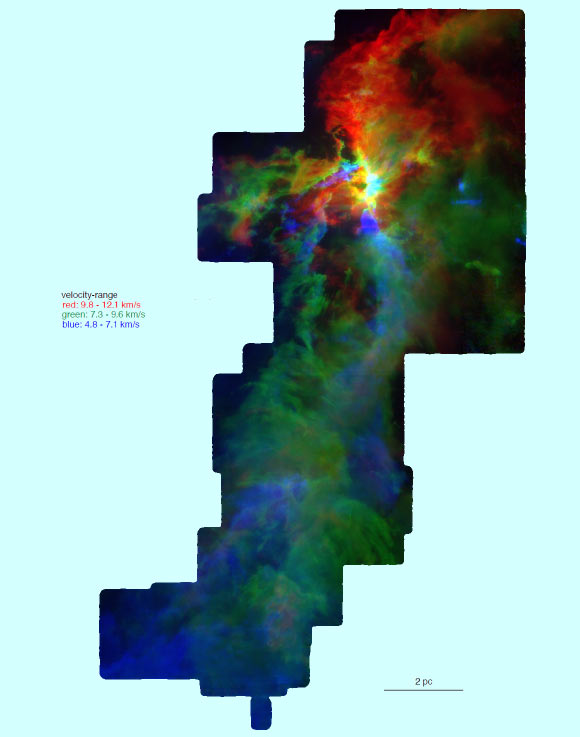The new map, created by astronomers from Yale University and elsewhere, provides unprecedented detail of the structure of the Orion A molecular cloud, the closest star-forming region of high-mass stars.

Gas in the Orion A molecular cloud; each of the three colors (red, green and blue) represents a different velocity range. Image credit: National Science Foundation / S. Kong, J. Feddersen & H. Arce, CARMA-NRO Orion Survey Team.
The Orion A cloud provides an ideal laboratory to map an extended molecular cloud in detail and address many scientific questions.
This cloud is one of two giant molecular clouds in the Orion molecular cloud complex; the other cloud is Orion B, which lies east of Orion’s Belt.
Orion A contains both high- and low-mass young stellar objects and hosts a variety of star-forming environments, including dense star clusters similar to the one where Earth’s Sun is believed to have formed.
Perhaps most importantly, at a distance of about 1,305 light-years it is the closest site of massive star formation.
“Our map probes a wide range of physical scales needed to study how stars form in molecular clouds, and how young stars impact their parent cloud,” said lead author Dr. Shuo Kong, a postdoctoral researcher at Yale University.
“We constructed the map of the Orion A cloud by combining data from a single-dish telescope and an interferometer.”
The new dataset and map are collectively known as the CARMA-NRO Orion Survey.
The name refers to the Combined Array for Research in Millimeter Astronomy (CARMA), an interferometer that was located in California, and the Nobeyama Radio Observatory (NRO) telescope, in Japan.
“Our survey is a unique combination of data from two very different telescopes,” said co-author Jesse Feddersen, a graduate student at Yale University.
“We combined the zoom of CARMA with the wide-angle of NRO to simultaneously capture the details of individual forming stars and the overall shape and motions of the giant molecular cloud.”
In addition, the map will help researchers calibrate star formation models for extragalactic studies.
“The data we provide here will benefit research on a broad range of evolutionary stages of the star formation process and on the environment stars form,” said co-author Professor Héctor G. Arce, also of Yale University.
The findings were published in the Astrophysical Journal Supplement Series (arXiv.org preprint).
_____
Shuo Kong et al. 2018. The CARMA-NRO Orion Survey. ApJS 236, 25; doi: 10.3847/1538-4365/aabafc







